人工智能英文版
- 格式:ppt
- 大小:1.04 MB
- 文档页数:20
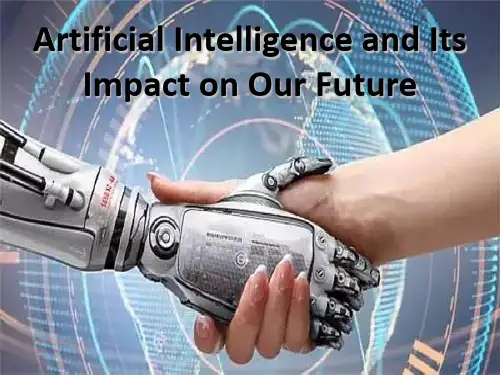
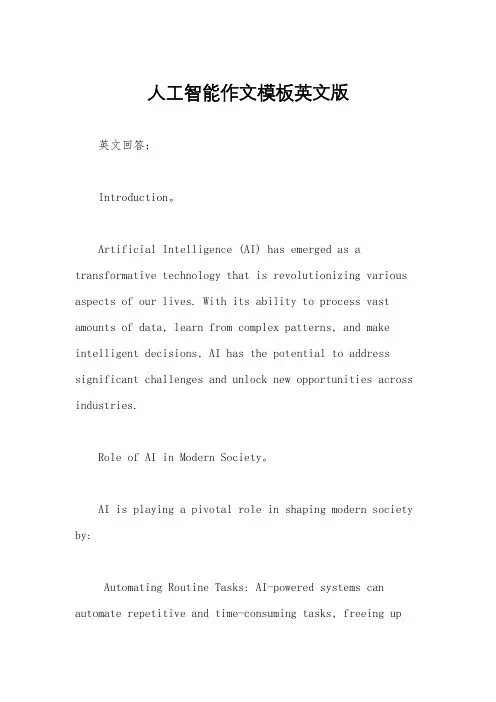
人工智能作文模板英文版英文回答:Introduction。
Artificial Intelligence (AI) has emerged as a transformative technology that is revolutionizing various aspects of our lives. With its ability to process vast amounts of data, learn from complex patterns, and make intelligent decisions, AI has the potential to address significant challenges and unlock new opportunities across industries.Role of AI in Modern Society。
AI is playing a pivotal role in shaping modern society by:Automating Routine Tasks: AI-powered systems can automate repetitive and time-consuming tasks, freeing uphuman workers to focus on more strategic and creative endeavors.Enhancing Decision-Making: AI algorithms can analyze large volumes of data to identify patterns and correlations that are often invisible to humans. This enables businesses and individuals to make informed decisions and optimize outcomes.Improving Healthcare Outcomes: AI is transforming healthcare by enabling early disease detection, personalized treatment plans, and automated medical image analysis.Advancing Transportation: Self-driving cars, traffic management systems, and drone delivery services based on AI are revolutionizing the transportation industry, making it safer, more efficient, and accessible.Personalizing Experiences: AI algorithms are used to tailor content, products, and services to individual preferences, creating personalized experiences for users.Ethical Considerations。
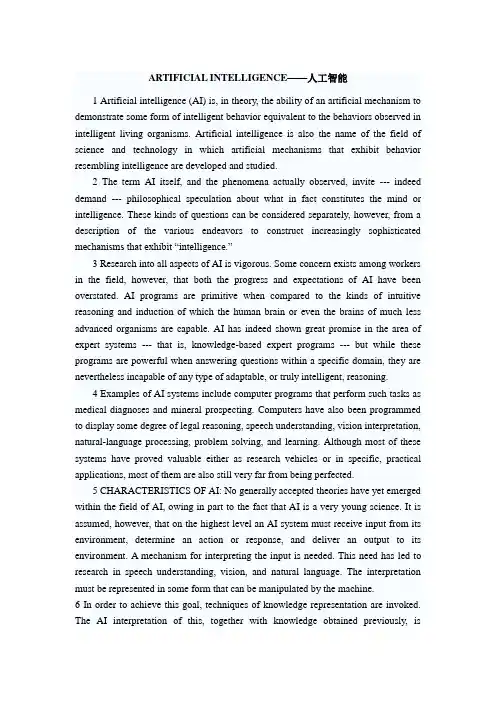
ARTIFICIAL INTELLIGENCE——人工智能1 Artificial intelligence (AI) is, in theory, the ability of an artificial mechanism to demonstrate some form of intelligent behavior equivalent to the behaviors observed in intelligent living organisms. Artificial intelligence is also the name of the field of science and technology in which artificial mechanisms that exhibit behavior resembling intelligence are developed and studied.2 The term AI itself, and the phenomena actually observed, invite --- indeed demand --- philosophical speculation about what in fact constitutes the mind or intelligence. These kinds of questions can be considered separately, however, from a description of the various endeavors to construct increasingly sophisticated mechanisms that exhibit “intelligence.”3 Research into all aspects of AI is vigorous. Some concern exists among workers in the field, however, that both the progress and expectations of AI have been overstated. AI programs are primitive when compared to the kinds of intuitive reasoning and induction of which the human brain or even the brains of much less advanced organisms are capable. AI has indeed shown great promise in the area of expert systems --- that is, knowledge-based expert programs --- but while these programs are powerful when answering questions within a specific domain, they are nevertheless incapable of any type of adaptable, or truly intelligent, reasoning.4 Examples of AI systems include computer programs that perform such tasks as medical diagnoses and mineral prospecting. Computers have also been programmed to display some degree of legal reasoning, speech understanding, vision interpretation, natural-language processing, problem solving, and learning. Although most of these systems have proved valuable either as research vehicles or in specific, practical applications, most of them are also still very far from being perfected.5 CHARACTERISTICS OF AI: No generally accepted theories have yet emerged within the field of AI, owing in part to the fact that AI is a very young science. It is assumed, however, that on the highest level an AI system must receive input from its environment, determine an action or response, and deliver an output to its environment. A mechanism for interpreting the input is needed. This need has led to research in speech understanding, vision, and natural language. The interpretation must be represented in some form that can be manipulated by the machine.6 In order to achieve this goal, techniques of knowledge representation are invoked. The AI interpretation of this, together with knowledge obtained previously, ismanipulated within the system under study by means of some mechanism or algorithm. The system thus arrives at an internal representation of the response or action. The development of such processes requires techniques of expert reasoning, common-sense reasoning, problem solving, planning, signal interpretation, and learning. Finally, the system must网construct an effective response. This requires techniques of natural-language generation.7 THE FIFTH-GENERATION ATTEMPT: In the 1980s, in an attempt to develop an expert system on a very large scale, the Japanese government began building powerful computers with hardware that made logical inferences in the computer language PROLOG. (Following the idea of representing knowledge declaratively, the logic programming PROLOG had been developed in England and France. PROLOG is actually an inference engine that searches declared facts and rules to confirm or deny a hypothesis. A drawback of PROLOG is that it cannot be altered by the programmer.) The Japanese referred to such machines as “fifth-generation” computers.8 By the early 1990s, however, Japan had forsaken this plan and even announced that they were ready to release its software. Although they did not detail reasons for their abandonment of the fifth-generation program, U.S scientists faulted their efforts at AI as being too much in the direction of computer-type logic and too little in the direction of human thinking processes. The choice of PROLOG was also criticized. Other nations were by then not developing software in that computer language and were showing little further enthusiasm for it. Furthermore, the Japanese were not making much progress in parallel processing, a kind of computer architecture involving many independent processors working together in parallel—a method increasingly important in the field of computer science. The Japanese have now defined a “sixth-generation” goal instead, called the Real World Computing Project, that veers away from the expert-systems approach that works only by built-in logical rules.9 THE FUTURE OF AI RESEARCH: One impediment to building even more useful expert systems has been, from the start, the problem of input---in particular, the feeding of raw data into an AI system. To this end, much effort has been devoted to speech recognition, character recognition, machine vision, and natural-language processing. A second problem is in obtaining knowledge. It has proved arduous toextract knowledge from an expert and then code it for use by the machine, so a great deal of effort is also being devoted to learning and knowledge acquisition.10 One of the most useful ideas that has emerged from AI research, however, is that facts and rules (declarative knowledge) can be represented separately from decision-making algorithms (procedural knowledge). This realization has had a profound effect both on the way that scientists approach problems and on the engineering techniques used to produce AI systems. By adopting a particular procedural element, called an inference engine, development of an AI system is reduced to obtaining and codifying sufficient rules and facts from the problem domain. This codification process is called knowledge engineering. Reducing system development to knowledge engineering has opened the door to non-AI practitioners. In addition, business and industry have been recruiting AI scientists to build expert systems.11 In particular, a large number of these problems in the AI field have been associated with robotics. There are, first of all, the mechanical problems of getting a machine to make very precise or delicate movements. Beyond that are the much more difficult problems of programming sequences of movements that will enable a robot to interact effectively with a natural environment, rather than some carefully designed laboratory setting. Much work in this area involves problem solving and planning.12 A radical approach to such problems has been to abandon the aim of developing “reasoning” AI systems and to produce, instead, robots that function “reflexively”. A leading figure in this field has been Rodney Brooks of the Massachusetts Institute of Technology. These AI researchers felt that preceding efforts in robotics were doomed to failure because the systems produced could not function in the real world. Rather than trying to construct integrated networks that operate under a centralizing control and maintain a logically consistent model of the world, they are pursuing a behavior-based approach named subsumption architecture.13 Subsumption architecture employs a design technique called “layering,”---a form of parallel processing in which each layer is a separate behavior-producing network that functions on its own, with no central control. No true separation exists, in these layers, between data and computation. Both of them are distributed over the same networks. Connections between sensors and actuators in these systems are kept short as well. The resulting robots might be called “mindless,” but in fact they have demonstrated remarkable abilities to learn and to adapt to real-life circumstances.14 The apparent successes of this new approach have not convinced many supporters of integrated-systems development that the alternative is a valid one for drawing nearer to the goal of producing true AI. The arguments that have arisen between practitioners of the two different methodologies are in fact profound ones. They have implications about the nature of intelligence in general, whether natural or artificial。
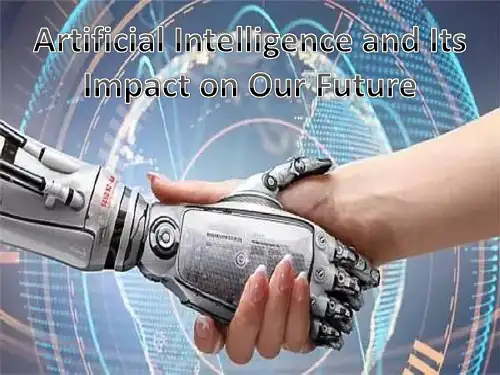
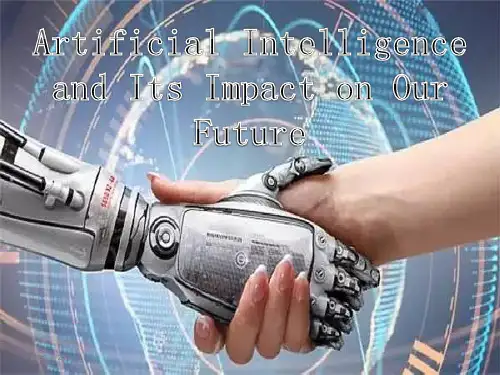
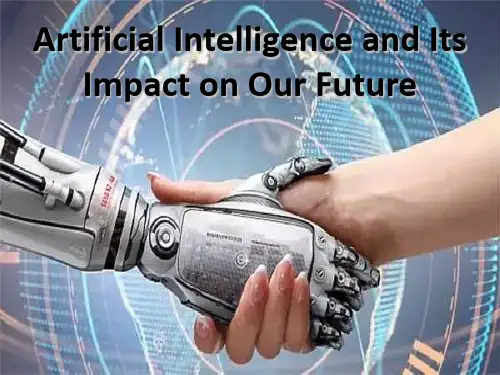
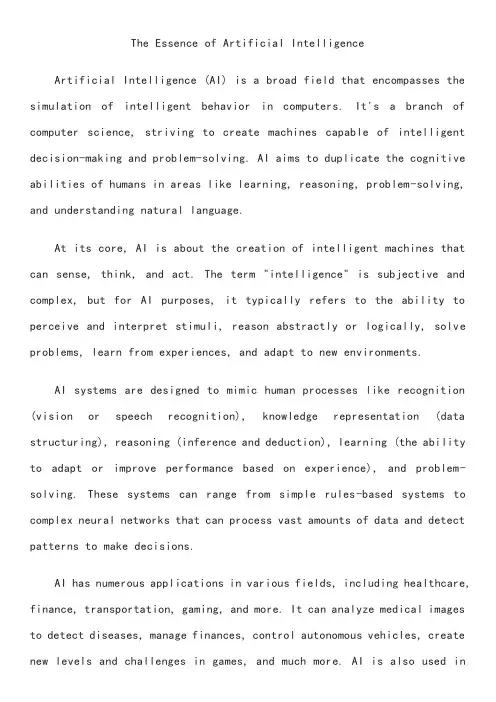
The Essence of Artificial IntelligenceArtificial Intelligence (AI) is a broad field that encompasses the simulation of intelligent behavior in computers. It's a branch of computer science, striving to create machines capable of intelligent decision-making and problem-solving. AI aims to duplicate the cognitive abilities of humans in areas like learning, reasoning, problem-solving, and understanding natural language.At its core, AI is about the creation of intelligent machines that can sense, think, and act. The term "intelligence" is subjective and complex, but for AI purposes, it typically refers to the ability to perceive and interpret stimuli, reason abstractly or logically, solve problems, learn from experiences, and adapt to new environments.AI systems are designed to mimic human processes like recognition (vision or speech recognition), knowledge representation (data structuring), reasoning (inference and deduction), learning (the ability to adapt or improve performance based on experience), and problem-solving. These systems can range from simple rules-based systems to complex neural networks that can process vast amounts of data and detect patterns to make decisions.AI has numerous applications in various fields, including healthcare, finance, transportation, gaming, and more. It can analyze medical images to detect diseases, manage finances, control autonomous vehicles, create new levels and challenges in games, and much more. AI is also used invoice assistants like Siri or Alexa, which can understand and respond to natural language.AI is continuously evolving as technology progresses. Current research is exploring new techniques like transfer learning and deep learning to create more robust AI systems that can handle increasingly complex tasks. As AI matures, we can expect even more profound impacts on society and the world around us.。
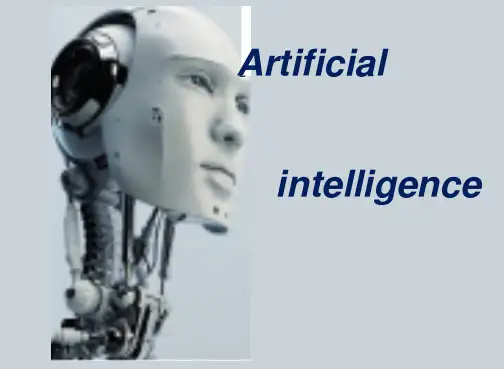
Artificial intelligenceArtificial in tellige nee (Al) is in the spotlight of this year's World Inter net Conference. The tech no logy focuses on how to create computers and software that are capable of intelligent behavior.Al is widely applied in autonomous vehicles, medical diagnosis, stock t「ading, robot control, remote sensing, scientific discovery, criminal investigation and toys. ⑥ARTViaAl WIH1 IGFF«Tjnp4 Machines equipped with the system can take over jobs that can be dangerous to humans in various industries. Other examples are automated online and telephone assistants・ Al is also applied to smart phones and apps, like fingerprint sensors and Apple's assistant, Siri.Progress in Al tech no logy that can recognize patter ns offer the possibility of machines that perform human activities like seeing, listening and thin king ・But debates on the tech no logy's future is never en ding. Some worry that if machines replace humans,unemployment will spike and, like a futuristic movie twist, that the system could even grow beyond human control.Artificial intelligence js to use computers to analog and in stead of human brain ・ The advent ofcomputers has made artificial intelligence a majorbreakthrough. The computer can not only replace some of the human brain function, but exceed the human brain greatly in speed and accuracy 」t can not only simulate part of analysis and the comprehensive function, but is getting to display a certain characteristics ofconsciousness .It really became an extension of the human brain.What is Al?Systems that think like humansThe exciting new effort to make computers thinks ・・.machine with minds, in the full and literal sense (Haugeland 1985)Systems that think ration ally“The study of mental faculties through the use of computational models”(Charniak et al. 1985) What is Al?Views of Al fall into four categories:Systems that act like humans“The art of creating machines that perform functions that require intelligenee when performed by people” (Kurzweil, 1990) Systems that act rati on allyA field of study that seeks to explai n and emulate intelligent behavior in terms ofcomputational processes M (Schalkol, 1990)Main Goal of Al•Represent and store knowledge(表示并存储知识)•Retrieve and reason about knowledge(知识检索和思考)•Behave intelligently in complex envir onmerits(在复杂环境屮表现卿能)•Develop interesting and usefulapplications(开发有趣和有用的应用程序)•Interact with people, agents, and theenvir on ment(与人,机构,坏境相交流)AppliancesLaborScience Googk "YXEioor Search enginesTuring test (1936)■Alan turing■(1912-1954)■Computers can foolpeople, people whobelieve it is not themachine, then itshould be calledintelligent.HUMAN PARTICIPANT COMPUTER PARTICIPANT JUDGEBirth of Al1956, the American scholar McCarthy who is considered thefather of artificial intelligence oforganized a Society, many expertsand scholars gathered together fora discussion of up to two months.Inviting them to participate in the"Summer Dartmouth ArtificialIntelligence Research Society."Since then, this field is named"artificial intelligence" McCarth y 麦卡锡Birth of AlMcCarth Minskyy麦卡锡明斯基Shannon 香农Birth of AlMore^ Samuel, Selfridge^ Solomonff 莫尔(Princeton )f 塞缪尔(IBM),塞尔夫里奇. 索罗莫夫(MIT)Simon-1975Newell-1975The first 10 years of achievement In machine learning, in 1957 Rosenblatt (罗森布拉特)successfully developed Perceptron(感矢口机);In theorem proving, in 1958 Wang Hao in the IBM-704 machine with a 3-5 minute proved all 220 theorem“ Principia Mathematica " in the relevant propositional calculus;ln 1965, Robin son made due to the resoluti on principle(归结原理);In pattern recognition(模式识别),1959 Selfridge(塞尔福里奇)launched a pattern recognition program; 1965 Roberts prepared a distinguished building block construction procedures(可分辨积木构造程序);The first 10 years of achievementIn terms of problem solving(问题求解):1960 Newell (纽厄尔j compiled a universal problem solver (GPS), can solve 11 different types of problems;In expert systems(专家系统):the results of the 1968 Feigenbaum(费根鲍姆)developed DENDRAL expert system and put into use;In the artificial intelligence language(人工智能语言):1960 McCarthy (McCarthy) developed the artificial intelligenee language-LISP language.Difficulties (the late1960s)Secondary Translation ・ Machine Translation the spirit is willing but the flesh is weak the vodka is good but the meat is rottenCombinatorial explosion problem (组合爆炸)The fact that a program can find a solution in p「inciple does not means that the program con tains any of the mechanisms n eeded to find it in practice・Perceptron limitations(感知机局限性)A two-input perceptron cannot be trained to recognize when its two inputs are d iff ere nt.Knowledge Engineering (1977)■ Feigenbaum(费根鲍姆)presented KnowledgeEngineering at the 5th IJCAI(lnternational Joint Conference On Artificial Intelligence,国际人工智能联合会议)Neural Networks■ Hopfield Neural Networks (Hopfield,霍普菲尔德,1982)■ Back-propagation ■algorithm (Rumelhart & I McClelland,鲁梅尔哈特,麦I 克莱伦德1986)lf sthe r most common neural 电network WComputational Intelligence thriving (90s-now)Artificial Neural Network人工神经网络Genetic Algorithm遗传算法Fuzzy Reasoning模糊推理Ant Colony Algorithm蚁群算法Particle Swarm Optimization粒子群优化Artificial Immune System人工免疫系统The History of Al Present Computational Intelligenc 1977 Neural Networks Reborn Knowledge Engineerin Difficulties 1 6 王热) Enthusiasm BirtlZ 1956 Al was launched 197 ^l^IJCAIwas held •国际人工智能联合会议The great achievements of artificial intelligence May 1997, the U.S. IBM's “Deep Blue” supercomputer beatthe world chess championGarry Kasparov(卡斯帕罗夫).Artificial intelligenee can be scripted as a new scienee and tech no logy, which is used to simulate huma n in telligence. We can't deny the fact that artificial intelligence is of great important nowadays.Will robots ever be able to replace people?Altificial intelligence (人工智能)Turing test (图灵测试)pattern recognition(模式识另ij)expert systems(专家系统)Neural Network (神经网络)。
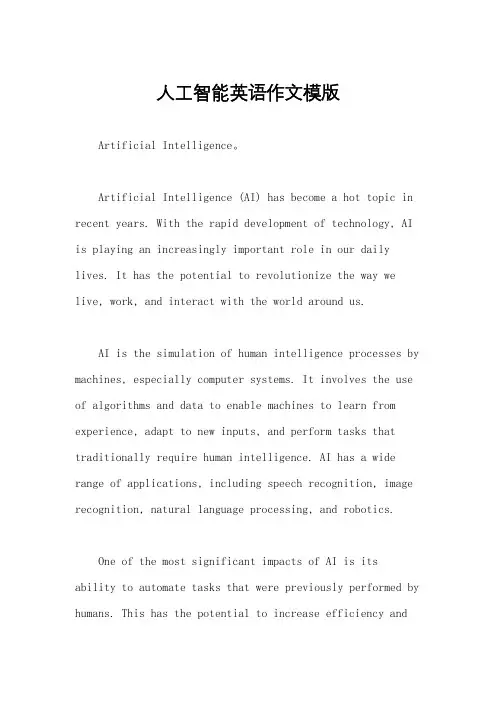
人工智能英语作文模版Artificial Intelligence。
Artificial Intelligence (AI) has become a hot topic in recent years. With the rapid development of technology, AI is playing an increasingly important role in our daily lives. It has the potential to revolutionize the way we live, work, and interact with the world around us.AI is the simulation of human intelligence processes by machines, especially computer systems. It involves the use of algorithms and data to enable machines to learn from experience, adapt to new inputs, and perform tasks that traditionally require human intelligence. AI has a wide range of applications, including speech recognition, image recognition, natural language processing, and robotics.One of the most significant impacts of AI is itsability to automate tasks that were previously performed by humans. This has the potential to increase efficiency andproductivity in a wide range of industries, from manufacturing and logistics to healthcare and finance. For example, AI-powered robots can be used to performrepetitive and dangerous tasks in factories, freeing up human workers to focus on more complex and creative tasks. In the healthcare industry, AI can be used to analyze medical images and data, helping doctors to make more accurate diagnoses and develop personalized treatment plans for patients.AI also has the potential to transform the way we interact with technology. Virtual assistants like Siri and Alexa are already becoming an integral part of our daily lives, helping us to perform tasks such as setting reminders, checking the weather, and playing music. As AI technology continues to advance, virtual assistants will become even more intelligent and capable, providing us with personalized recommendations and assistance in a wide range of tasks.However, the rapid development of AI also raises a number of ethical and societal concerns. For example, thereare concerns about the potential impact of AI on the job market, as automation could lead to the displacement of human workers. There are also concerns about the potential for AI to be used in ways that infringe on privacy andcivil liberties, such as the use of facial recognition technology for surveillance purposes.In order to address these concerns, it is important for policymakers, technologists, and society as a whole to work together to ensure that AI is developed and used in a responsible and ethical manner. This includes developing regulations and guidelines to govern the use of AI, as well as investing in education and training to ensure that workers are equipped with the skills they need to thrive in an AI-powered economy.In conclusion, AI has the potential to revolutionize the way we live and work. While it presents a number of challenges, it also offers tremendous opportunities to improve efficiency, productivity, and quality of life. By working together to address the ethical and societalconcerns associated with AI, we can ensure that it is used in a way that benefits society as a whole.。

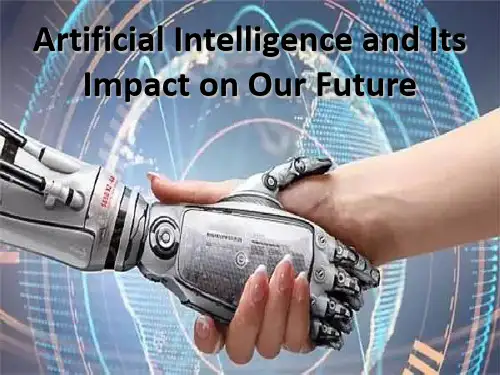
人工智能英文版第五版课程设计Course DescriptionArtificial Intelligence () is an interdisciplinary field that focuses on creating intelligent machines, which can perform tasks that typically require human-like thinking and problem-solving abilities. This course introduces students to the fundamental principles and techniques of , including machine learning, natural language processing, computer vision, and robotics. Students will gn hands-on experience building systems using Python and popular libraries such as TensorFlow and Keras.Course GoalsThe goals of this course are to:•Understand the fundamental concepts and techniques of•Develop skills in programming systems using Python and popular libraries•Explore the ethical and societal implications of PrerequisitesThis course assumes familiarity with basic programming concepts and syntax. Students should also have a solid understanding of linear algebra, probability, and statistics. Familiarity with Python is not required but is recommended.Course OutlineModule 1: Introduction to•Overview of and its history•Types of systems•Applications of in various fields•Ethical concerns inModule 2: Machine Learning•Supervised learning•Unsupervised learning•Reinforcement learning•Neural networks•Deep learningModule 3: Natural Language Processing•Text classification•Sentiment analysis•Named entity recognition•Language modelingModule 4: Computer Vision•Image classification•Object detection•Facial recognition•Deep learning for computer vision Module 5: Robotics•Introduction to robotics•Robot kinematics•Robot control systems•Computer vision for roboticsModule 6: Advanced Topics•Generative adversarial networks (GANs)•Transfer learning•Explnable•Adversarial examples and defensesAssignments and GradingThe course will include programming assignments, quizzes, and afinal project. The assignments and quizzes will be weighted equally and will account for 70% of the grade. The final project will account for the remning 30% of the grade. The grading scale is as follows:•A: 90-100%•B: 80-89%•C: 70-79%•D: 60-69%•F: below 60%Textbook。